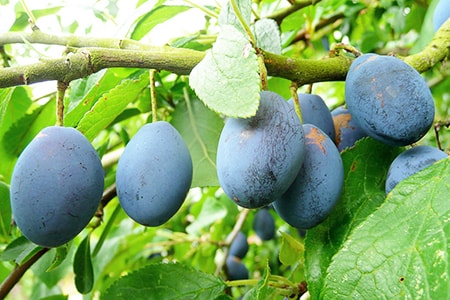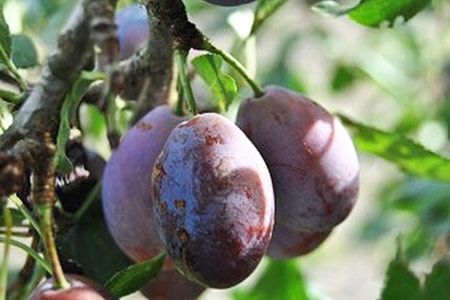11 Types of Plums: Every Taste & Color Pictured Here
Author: Jen Worst | Editor: Omar Alonso
Review & Research: Jen Worst & Chris Miller

Of the various types of plums, most of us have probably only tasted a few at most and possibly are even unaware that there are different kinds. The varieties aren't endless, and in fact number under a dozen.
Fun fact: plums are believed to be the first type of fruits cultivated by human beings. It's supposed to have started in Eastern Europe and the mountains near Caspian Sea.
Some believe that they were then carried to Rome around 200 BC and subsequently introduced to northern Europe. And were supposedly domesticated by the Chinese around 479 BC.
While there's no way to tell how much of that's true, the fact is that wild plums were grown all over the Old and New Worlds. The most popular type of plums now are Japanese plums and come in black, red and yellow colors.
Black plums have mild to sweet taste and are usually used in tarts to add texture to baked dishes. The red ones have a sweet-tart flavor, and the yellow varieties are smaller, rounder and are also called lemon plums. They have a crisp and firm texture and are great for pies and jams.
11 Types of Plums
We've as humans have been enjoying plums since the Neolithic age, coming in around 35 calories each. These delightfully healthy fruits come in a range of plum varieties and pretty amazing flavors. Check them out below.
1) Damson Plum

This is a European variety of plum with dark skin and tart-flavored skin and flesh. Although damsons are high in sugar content, they taste a bit bitter and are acidic.
Their skin is purplish-blue in color and the flesh is often yellowish-green and has a sour taste which makes them a great addition to sweet and savory dishes.
Damson plums are usually harvested from late August to October and come in multiple cultivar sub-species like Prunus domestica insititia.
2) Elephant Heart Plum

Unsurprisingly, this variety of plums is a large stone fruit that comes in the shape of a heart. Its skin ranges from dark red to purple and has a firm texture.
The flesh of the fruit is sweet and juicy red to the point where some say it feels like drinking juice. It's classified as a Japanese plum and is delicious while it is still fresh.
This variety also strikes a wonderful balance between sweetness and tartness, which is a defining feature of the flesh while the skin tastes like berries. The elephant heart plum is typically picked between September and October.
3) Moyer Plum

This one is considered to be one of the best European variety and best types of plums, period. It's longer and hence less round than the other plums.
Luckily, these are often freshly available and have a pleasant flavor. But if you let them dry out, they can be added to many dry dishes. They're still impeccably sweet though which is why they're called sugar plums.
This crop is best planted with other European plums like the brooks plum. The best thing about moyer plums is that they don't get affected by pests, though you'll want to watch out for bacterial attacks. This variety is also sold as Italian plums or prunes.
4) Greengage Plum

These plum types appear in a shade of pale yellow-green to bright lime and have red specks on the surface. But that's their natural color even after the fruits mature.
If you expect them to taste a little sour like other green fruits, you'll be pleasantly surprised by their sweetness. In fact, greengage plums have the most sugar content of all the types of plums.
Greengage plums come from small to medium sizes, depending on the variety and have a dense and juicy flesh with a great balance of sweetness and the acidity of citrus fruits.
These plums are sold in the summer as Imperial Gage, Reine Claude, Bryanston, Golden Transparent, Laxton’s Gage and Cambridge Gage.
Each of these varieties has a different skin and flesh color and flavor. This variety of plums is versatile and is used in making pies, ice creams, cakes, and many types of jams. Greengage plums can also be paired with savory foods like ricotta, basil, chili, and seafood.
5) French Prune

This is a fresh European-style plum variety that's great when dried to make prunes. The production of dried plums is interesting in itself if you're curious. It's a stone fruit that's oblong in shape, looks like a small pear, and is the size of a large walnut.
It has dark and smokey skin that comes in purples and light blue hues and the flesh is dark amber. The tree is ready for harvesting in late summer and its variety called the Improved French prune is quite popular in the US. It's deliciously sweet when it's soft and similarly tart when firm.
6) Friar Plum

This is another of the types of plums from Japan that has a skin that’s a lighter tone of amber. That usually ranges from dark violet to a bright black color and is round in shape.
Their flesh is usually in an orangey-amber shade. They're sweet and juicy with a small pit. They're available in late season and take about three weeks to mature after the Black Ruby.
Its firm flesh makes Friar a popular plum variety to be eaten fresh. These trees have a long harvesting time as this bumper crop is ready only in late August.
7) Mirabelle Plum

You know them better as cherry plums (they are not types of cherries) that are really small but surprisingly sweet. They're typically grown in a part of France and are well known for their use in jams, jellies, fruit brandy, and some baked goods.
Mirabelle plums are one of the rarest kinds of plums and aren’t found in many parts of the world. They're also difficult to import to other countries from France because of quality control.
Paradoxically though, you can grow them in your own garden if you find an authentic and reliable supplier who can procure good-quality saplings.
You must make sure they grow in a big space with regular care and maintenance for them to grow healthily. Know the best time to plant fruit trees before you embark on this journey, though.
8) Myrobalan Plum

These are also sometimes referred to as cherry plums because they look like small, round, red or yellow cherries. They come in many cultivar forms and their taste ranges from sweet to tart.
They're delicious if you get them fresh but they’re also used in baking and the making of jelly. These trees are popularly grown in backyard farms as ornamental types of fruit trees.
While the fruit itself is small and round, the plant grows to the size of shrubs in a small garden. This variety is also known to be one of the first trees to produce flowers in the spring season.
9) Black Beauty Plum

This is another variety of Japanese plums that has a bright yellow flesh and a dark purple-red skin. It's an extremely juicy stone fruit with firm flesh and grows from medium to large sizes.
This is also a plum that must be consumed when it's still fresh. The best way to figure out which of these is fresh is to gently squeeze the fruit and see if it is slightly soft.
If the plum is hard and unripe, store them at room temperature and wait for the magic to unravel. Black beauty is also a plum variety with a great balance of sweetness and tartness.
10) Plumcots

These are an early hybrid of plums and apricots with more qualities from the former than the latter. They have a yellowish-green skin and a bold pinkish red flesh.
They're oval shaped and are firm and crisp. This makes them an excellent choice to use in the making of mint salsa. But you can also use them to make jams, chutneys, and plum crumbles.
These plums are ready for harvest in late July and August and can be exported without the fear of damage.
11) Pluots

While they are often grouped with plucots, these fruits have a smooth reddish skin with their flesh in a tinge of yellow. There are a variety of pluots that are sold as Dapple Dandy, Flavor Grenade, Flavorglo, or Dinosaur Egg.
This hybrid is also best consumed fresh while they are fragrant, firm, and vibrant in appearance. If you find them in a soggy form, that means they're still unripe and must be kept at room temperature for three days or in a refrigerator for about a week.
Which are Your Favorite Types of Plums?
Plums are the delicious tart-flavored fruits many have come to love, especially if they had a plum tree around growing up. Some of them bear an uncanny resemblance to cherries and many types of peaches in the sense that they are a great source of many of the same nutrients.
They're amazing when added to jams and jellies. But if that’s not your thing, you could eat them just the way they are and still experience a slice of heaven in your mouth. Try all of the types of plums and then maybe try growing a tree of your favorite!



